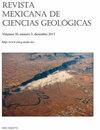来自树木年代学方法的碎片流分析ixtacamaxtitlan, Sierra north de Puebla, mexico
IF 0.5
4区 地球科学
Q4 GEOSCIENCES, MULTIDISCIPLINARY
Revista Mexicana De Ciencias Geologicas
Pub Date : 2020-07-28
DOI:10.22201/cgeo.20072902e.2020.2.1556
引用次数: 0
摘要
由于其潜在的后果,例如1999年10月在北普埃布拉山脉发生的数百次山体滑坡所引发的灾难,群众运动过程是墨西哥最严重的地貌灾害之一。本文基于地貌学和树木地貌学方法,对位于北普埃布拉山脉Tenextepecuaco山两个山谷的泥石流进行了重建和分析。从37棵刺柏树中,我们制作了一个当地参考年表,同时也确定了泥石流事件的年代和地图,最后利用树木的年龄来确定地形的稳定性/不稳定性。1992 ~ 2013年5 ~ 10月24 h最大降水序列与树轮宽度指数对比分析表明,2007年8月和2010年8月,西部河谷的两个通道分别因93和56 mm的强降水而重新激活。由于这一事件,一些树木年轮序列记录了生长抑制,Google EarthTM也通过植被覆盖的变化在卫星图像中观察到这一点。其他树种在2013年的生长抑制较少,通道保持活跃。自2014年以来,一些树木表现出生长释放,并且在Google EarthTM卫星图像中也发现了树木的再定殖,这表明地貌具有明显的稳定性。所采用的方法表明,青柏有潜力用于msamicxico的树木地貌研究,也可用于其他地貌研究。此外,研究的特定结果可有助于在区域范围内预防和减轻自然灾害的现有努力。本文章由计算机程序翻译,如有差异,请以英文原文为准。
Análisis de flujos de escombros desde un enfoque dendrocronológico en Ixtacamaxtitlán, Sierra Norte de Puebla, México
Owing to their potential consequences, such as the disaster triggered by hundreds of landslides in October 1999 in the mountain range Sierra Norte de Puebla, mass movement processes are among the most significant geomorphological hazards in Mexico. In this paper, we presented the reconstruction and analysis of debris flows at two valleys located on the Tenextepecuaco mountain in the Sierra Norte de Puebla, based on geomorphologic and dendrogeomorphic methods. From 37 Juniperus deppeana trees we made a Local Reference Chronology, also to dating and mapping the debris flow events and finally for determine the stability/instability of the landforms using the age of the trees. The comparative analysis of the maximum rainfall series in 24 hours, for the period from May to October from 1992 to 2013, and the tree-ring width index suggested that in August 2007 and August 2010 two channels of the western valley were reactivated triggered by heavy rainfall amounting 93 and 56 mm, respectively. As a result of such event, some tree-rings series recorded a growth suppression, and that was also observed in satellite images by Google EarthTM through changes in the vegetation cover. Other trees showed a less growth suppressions in 2013 and the channels were kept active. Since 2014, some trees showed a growth release, and recolonization of trees was also identified in the satellite imagery by Google EarthTM, suggesting an apparent geomorphological stability. The applied methodology showed the potential of Juniperus deppeana to be used for dendrogeomorphic studies in México, also in others geomorphic context. Additionally, particular results of the study can contribute to the existing efforts on prevention and mitigation of natural hazards within the regional context.
求助全文
通过发布文献求助,成功后即可免费获取论文全文。
去求助
来源期刊

Revista Mexicana De Ciencias Geologicas
地学-地球科学综合
CiteScore
1.00
自引率
12.50%
发文量
0
审稿时长
6-12 weeks
期刊介绍:
Revista Mexicana de Ciencias Geológicas (RMCG) publishes original research papers on geological processes of broad interest, and particularly those dealing with regions of Latin America. The RMCG also publishes review papers on topics of current interest, and on the geology and tectonics of geological provinces of Latin America. Besides, it offers the opportunity for host editors to publish special thematic issues.
 求助内容:
求助内容: 应助结果提醒方式:
应助结果提醒方式:


